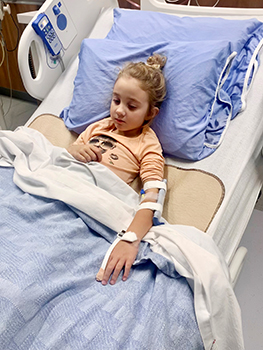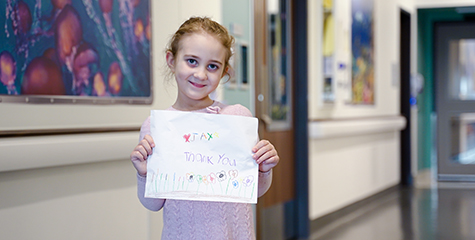When respiratory illnesses collide
One family's fight against the triple threat
“She’ll need to stay overnight.”
 Jax was on day four of a fever that would not break. Her cough was getting worse, and her energy level had gone down dramatically. She slept all the time. She wasn’t interested in watching TV or playing games on her tablet. She had not eaten in days and drank very little.
Jax was on day four of a fever that would not break. Her cough was getting worse, and her energy level had gone down dramatically. She slept all the time. She wasn’t interested in watching TV or playing games on her tablet. She had not eaten in days and drank very little.
For Marisa and Jason, Jax’s mom and dad, this behaviour was alarming. Their normally boisterous little girl loved playing Roblox or dancing in the living room, and she never met a French Fry she didn’t love.
Jax's experience was very concerning, and it was similar to what Mackenzie Health physicians had been seeing in other kids presenting at the Emergency Department: high fevers and breathing difficulties, and young children under five years of age were experiencing the most severe outcomes.
Marisa and Jason rushed Jax to Magna Emergency at Cortellucci Vaughan Hospital. After a series of tests, she was diagnosed with pneumonia and influenza.
Jax needed to be admitted. She also needed antibiotics for the infection, an IV for dehydration and a team of health care professionals to monitor her.
Unfortunately, Jax was among many little ones needing to be admitted that day.
Dr. Filippe Scerbo, Chief of Pediatrics at Mackenzie Health, admits it has been a tough season.
“We have seen record numbers of children coming into our Emergency Departments and Urgent Care Clinics with respiratory illnesses, many requiring admission to hospital.”
In fact, the number of children doubled compared to the flu season of 2021. The triple threat of COVID-19, influenza, and respiratory syncytial virus (RSV) was putting added pressure on the inpatient pediatric unit. At times, exceeding 250 per cent of the pediatric bed capacity.
With such demand, the health care teams had to get innovative to create additional capacity. Sometimes that meant the Emergency Department acting as a surge space for children waiting for a bed. The postpartum unit in the Woman and Child Program was also relocated as a short-term strategy to free up more beds for pediatric patients all in one area.
 Over the next couple of days, Jax’s medical team rallied around her to provide her with the best possible care, but also a warm and inviting experience.
Over the next couple of days, Jax’s medical team rallied around her to provide her with the best possible care, but also a warm and inviting experience.
At first scared and unsure, Jax was quickly set at ease.
Elaine, Mackenzie Health’s Child Life Specialist, was a friendly and assuring presence. She arrived at Jax’s room within a few hours to explain what all the funny looking buttons were, answered all her questions and brought her colouring books, stickers and stacks of pillowcases to choose from to make her hospital room feel more like home.
It wasn’t long before she was feeling better.
“We are thankful for the excellent care she received from her medical team,” Jason said. “They made us feel like they had the situation under control, and they kept us informed every step of the way.”